Assessment of Long-Term Photovoltaic (PV) Power Potential in China Based on High-Quality Solar Radiation and Optimal Tilt Angles of PV Panels
Abstract
Highlights
- High-quality diffuse solar radiation dataset is reconstructed to reassess 40 years of PV power potential over China.
- The optimal PV panel tilt angle for maximizing power generation is identified using long-term weather data.
- Optimizing the tilt angle is projected to increase China’s PV energy yield by 14.9 TWh/year based on 2023 PV installations.
- A novel tilt angle optimization model based on diffuse fraction is proposed.
Abstract
1. Introduction
2. Data and Methodology
2.1. Data and Preprocessing
2.1.1. Ground-Based Datasets
2.1.2. Reanalysis Datasets
2.2. Methodology
2.2.1. Estimation of Rdif
2.2.2. Optimization of PV Panel Tilt Angle
2.2.3. Estimation of PV CF
3. Results and Analysis
3.1. Validation of the Estimated Rdi
3.2. Validation of the Estimated PV CF
3.3. Optimal Tilt Angles of PV Panels over China
3.3.1. The Spatial Distribution of Optimized Tilt Angles
3.3.2. An Optimal Tilt Angle Model Based on Diffuse Fraction
3.3.3. The Impacts on PV Power Generation
3.4. Long-Term PV Power Potential over China
3.4.1. Spatial Patterns
3.4.2. Long-Term Variabilities
4. Discussion
4.1. The Impacts of Atmospheric Parameters on Rdif Estimation
4.2. Comparison of Optimized and Latitude-Dependent Tilt Angle Schemes
4.3. Comparison with Previous Studies on PV Potential over China
4.4. Uncertainty Analysis and Future Perspectives
5. Conclusions
Supplementary Materials
Author Contributions
Funding
Data Availability Statement
Acknowledgments
Conflicts of Interest
References
- Höök, M.; Tang, X. Depletion of Fossil Fuels and Anthropogenic Climate Change—A Review. Energy Policy 2013, 52, 797–809. [Google Scholar] [CrossRef]
- Sayed, E.; Olabi, A.; Alami, A.; Radwan, A.; Mdallal, A.; Rezk, A.; Abdelkareem, M. Renewable Energy and Energy Storage Systems. Energies 2023, 16, 1415. [Google Scholar] [CrossRef]
- Kabir, E.; Kumar, P.; Kumar, S.; Adelodun, A.A.; Kim, K.-H. Solar Energy: Potential and Future Prospects. Renew. Sustain. Energy Rev. 2018, 82, 894–900. [Google Scholar] [CrossRef]
- Renewable Capacity Statistics 2024. Available online: https://www.irena.org/Publications/2024/Mar/Renewable-capacity-statistics-2024 (accessed on 22 September 2024).
- Wang, Y.; He, J.; Chen, W. Distributed Solar Photovoltaic Development Potential and a Roadmap at the City Level in China. Renew. Sustain. Energy Rev. 2021, 141, 110772. [Google Scholar] [CrossRef]
- All Analysis—Analysis. Available online: https://www.iea.org/analysis (accessed on 4 June 2024).
- Ghosh, S.; Yadav, V.K.; Mukherjee, V.; Yadav, P. Evaluation of Relative Impact of Aerosols on Photovoltaic Cells through Combined Shannon’s Entropy and Data Envelopment Analysis (DEA). Renew. Energy 2017, 105, 344–353. [Google Scholar] [CrossRef]
- Gutiérrez, C.; Somot, S.; Nabat, P.; Mallet, M.; Gaertner, M.Á.; Perpiñán, O. Impact of Aerosols on the Spatiotemporal Variability of Photovoltaic Energy Production in the Euro-Mediterranean Area. Sol. Energy 2018, 174, 1142–1152. [Google Scholar] [CrossRef]
- Li, X.; Wagner, F.; Peng, W.; Yang, J.; Mauzerall, D.L. Reduction of Solar Photovoltaic Resources Due to Air Pollution in China. Proc. Natl. Acad. Sci. USA 2017, 114, 11867–11872. [Google Scholar] [CrossRef] [PubMed]
- Jiang, Y.; Yi, B. An Assessment of the Influences of Clouds on the Solar Photovoltaic Potential over China. Remote Sens. 2023, 15, 258. [Google Scholar] [CrossRef]
- Yang, J.; Yi, B.; Wang, S.; Liu, Y.; Li, Y. Diverse Cloud and Aerosol Impacts on Solar Photovoltaic Potential in Southern China and Northern India. Sci. Rep. 2022, 12, 19671. [Google Scholar] [CrossRef]
- AlSkaif, T.; Dev, S.; Visser, L.; Hossari, M.; van Sark, W. A Systematic Analysis of Meteorological Variables for PV Output Power Estimation. Renew. Energy 2020, 153, 12–22. [Google Scholar] [CrossRef]
- Chen, X.M.; Li, Y.; Zhao, Z.G.; Ma, T.; Wang, R.Z. General Method to Obtain Recommended Tilt and Azimuth Angles for Photovoltaic Systems Worldwide. Sol. Energy 2018, 172, 46–57. [Google Scholar] [CrossRef]
- Jacobson, M.Z.; Jadhav, V. World Estimates of PV Optimal Tilt Angles and Ratios of Sunlight Incident upon Tilted and Tracked PV Panels Relative to Horizontal Panels. Sol. Energy 2018, 169, 55–66. [Google Scholar] [CrossRef]
- Dubey, S.; Sarvaiya, J.N.; Seshadri, B. Temperature Dependent Photovoltaic (PV) Efficiency and Its Effect on PV Production in the World—A Review. Energy Procedia 2013, 33, 311–321. [Google Scholar] [CrossRef]
- Skoplaki, E.; Palyvos, J.A. On the Temperature Dependence of Photovoltaic Module Electrical Performance: A Review of Efficiency/Power Correlations. Sol. Energy 2009, 83, 614–624. [Google Scholar] [CrossRef]
- Chepp, E.D.; Krenzinger, A. A Methodology for Prediction and Assessment of Shading on PV Systems. Sol. Energy 2021, 216, 537–550. [Google Scholar] [CrossRef]
- Ramli, M.A.M.; Twaha, S.; Ishaque, K.; Al-Turki, Y.A. A Review on Maximum Power Point Tracking for Photovoltaic Systems with and without Shading Conditions. Renew. Sustain. Energy Rev. 2017, 67, 144–159. [Google Scholar] [CrossRef]
- Ghosh, S.; Kumar, A.; Ganguly, D.; Dey, S. India’s Photovoltaic Potential amidst Air Pollution and Land Constraints. Iscience 2023, 26, 107856. [Google Scholar] [CrossRef]
- Gunderson, I.; Goyette, S.; Gago-Silva, A.; Quiquerez, L.; Lehmann, A. Climate and Land-Use Change Impacts on Potential Solar Photovoltaic Power Generation in the Black Sea Region. Environ. Sci. Policy 2015, 46, 70–81. [Google Scholar] [CrossRef]
- Martín-Chivelet, N. Photovoltaic Potential and Land-Use Estimation Methodology. Energy 2016, 94, 233–242. [Google Scholar] [CrossRef]
- Huld, T.; Gottschalg, R.; Beyer, H.G.; Topič, M. Mapping the Performance of PV Modules, Effects of Module Type and Data Averaging. Sol. Energy 2010, 84, 324–338. [Google Scholar] [CrossRef]
- Tang, W.; He, J.; Qi, J.; Yang, K. A Dense Station-Based, Long-Term and High-Accuracy Dataset of Daily Surface Solar Radiation in China. Earth Syst. Sci. Data 2023, 15, 4537–4551. [Google Scholar] [CrossRef]
- Yang, S.; Wang, X.L.; Wild, M. Homogenization and Trend Analysis of the 1958–2016 In Situ Surface Solar Radiation Records in China. J. Clim. 2018, 31, 4529–4541. [Google Scholar] [CrossRef]
- Khorasanizadeh, H.; Mohammadi, K. Diffuse Solar Radiation on a Horizontal Surface: Reviewing and Categorizing the Empirical Models. Renew. Sustain. Energy Rev. 2016, 53, 338–362. [Google Scholar] [CrossRef]
- Zhu, T.; Li, J.; He, L.; Wu, D.; Tong, X.; Mu, Q.; Yu, Q. The Improvement and Comparison of Diffuse Radiation Models in Different Climatic Zones of China. Atmos. Res. 2021, 254, 105505. [Google Scholar] [CrossRef]
- López-Escalante, M.C.; Navarrete-Astorga, E.; Gabás Perez, M.; Ramos-Barrado, J.R.; Martín, F. Photovoltaic Modules Designed for Architectural Integration without Negative Performance Consequences. Appl. Energy 2020, 279, 115741. [Google Scholar] [CrossRef]
- Hafez, A.Z.; Soliman, A.; El-Metwally, K.A.; Ismail, I.M. Tilt and Azimuth Angles in Solar Energy Applications—A Review. Renew. Sustain. Energy Rev. 2017, 77, 147–168. [Google Scholar] [CrossRef]
- Yadav, A.K.; Chandel, S.S. Tilt Angle Optimization to Maximize Incident Solar Radiation: A Review. Renew. Sustain. Energy Rev. 2013, 23, 503–513. [Google Scholar] [CrossRef]
- de Vries, B.J.M.; van Vuuren, D.P.; Hoogwijk, M.M. Renewable Energy Sources: Their Global Potential for the First-Half of the 21st Century at a Global Level: An Integrated Approach. Energy Policy 2007, 35, 2590–2610. [Google Scholar] [CrossRef]
- Šúri, M.; Huld, T.A.; Dunlop, E.D.; Ossenbrink, H.A. Potential of Solar Electricity Generation in the European Union Member States and Candidate Countries. Sol. Energy 2007, 81, 1295–1305. [Google Scholar] [CrossRef]
- Gaiddon, B.; Jedliczka, M. Compared Assessment of Selected Environmental Indicators of Photovoltaic Electricity in OECD Cities. Int. Energy Agency Photovolt. Power Syst. Programme 2006, 11, 363–385. [Google Scholar]
- Kroposki, B.; Emery, K.; Myers, D.; Mrig, L. A Comparison of Photovoltaic Module Performance Evaluation Methodologies for Energy Ratings. In Proceedings of 1994 IEEE 1st World Conference on Photovoltaic Energy Conversion-WCPEC (A Joint Conference of PVSC, PVSEC and PSEC), Waikoloa, HI, USA, 5–9 December 1994; Volume 1, pp. 858–862. [Google Scholar]
- Bessho, K.; Date, K.; Hayashi, M.; Ikeda, A.; Imai, T.; Inoue, H.; Kumagai, Y.; Miyakawa, T.; Murata, H.; Ohno, T.; et al. An Introduction to Himawari-8/9—Japan’s New-Generation Geostationary Meteorological Satellites. J. Meteorol. Soc. Japan. Ser. II 2016, 94, 151–183. [Google Scholar] [CrossRef]
- Min, M.; Wu, C.; Li, C.; Liu, H.; Xu, N.; Wu, X.; Chen, L.; Wang, F.; Sun, F.; Qin, D.; et al. Developing the Science Product Algorithm Testbed for Chinese Next-Generation Geostationary Meteorological Satellites: Fengyun-4 Series. J. Meteorol. Res. 2017, 31, 708–719. [Google Scholar] [CrossRef]
- Gelaro, R.; McCarty, W.; Suárez, M.J.; Todling, R.; Molod, A.; Takacs, L.; Randles, C.A.; Darmenov, A.; Bosilovich, M.G.; Reichle, R.; et al. The Modern-Era Retrospective Analysis for Research and Applications, Version 2 (MERRA-2). J. Clim. 2017, 30, 5419–5454. [Google Scholar] [CrossRef]
- Hersbach, H.; Bell, B.; Berrisford, P.; Hirahara, S.; Horányi, A.; Muñoz-Sabater, J.; Nicolas, J.; Peubey, C.; Radu, R.; Schepers, D.; et al. The ERA5 Global Reanalysis. Quart. J. R. Meteoro Soc. 2020, 146, 1999–2049. [Google Scholar] [CrossRef]
- Zhang, H.; Cao, Y.; Zhang, Y.; Terzija, V. Quantitative Synergy Assessment of Regional Wind-Solar Energy Resources Based on MERRA Reanalysis Data. Appl. Energy 2018, 216, 172–182. [Google Scholar] [CrossRef]
- Magaña-González, R.C.; Rodríguez-Hernández, O.; Canul-Reyes, D.A. Analysis of Seasonal Variability and Complementarity of Wind and Solar Resources in Mexico. Sustain. Energy Technol. Assess. 2023, 60, 103456. [Google Scholar] [CrossRef]
- Sterl, S.; Liersch, S.; Koch, H.; van Lipzig, N.P.M.; Thiery, W. A New Approach for Assessing Synergies of Solar and Wind Power: Implications for West Africa. Environ. Res. Lett. 2018, 13, 094009. [Google Scholar] [CrossRef]
- Ramirez Camargo, L.; Schmidt, J. Simulation of Multi-Annual Time Series of Solar Photovoltaic Power: Is the ERA5-Land Reanalysis the next Big Step? Sustain. Energy Technol. Assess. 2020, 42, 100829. [Google Scholar] [CrossRef]
- Pfenninger, S.; Staffell, I. Long-Term Patterns of European PV Output Using 30 Years of Validated Hourly Reanalysis and Satellite Data. Energy 2016, 114, 1251–1265. [Google Scholar] [CrossRef]
- Jiang, H.; Yang, Y.; Bai, Y.; Wang, H. Evaluation of the Total, Direct, and Diffuse Solar Radiations From the ERA5 Reanalysis Data in China. IEEE Geosci. Remote Sens. Lett. 2020, 17, 47–51. [Google Scholar] [CrossRef]
- Qiu, T.; Wang, L.; Lu, Y.; Zhang, M.; Qin, W.; Wang, S.; Wang, L. Potential Assessment of Photovoltaic Power Generation in China. Renew. Sustain. Energy Rev. 2022, 154, 111900. [Google Scholar] [CrossRef]
- Sweerts, B.; Pfenninger, S.; Yang, S.; Folini, D.; Van Der Zwaan, B.; Wild, M. Estimation of Losses in Solar Energy Production from Air Pollution in China Since 1960 Using Surface Radiation Data. Nat. Energy 2019, 4, 657–663. [Google Scholar] [CrossRef]
- Song, Z.; Cao, S.; Yang, H. Assessment of Solar Radiation Resource and Photovoltaic Power Potential across China Based on Optimized Interpretable Machine Learning Model and GIS-Based Approaches. Appl. Energy 2023, 339, 121005. [Google Scholar] [CrossRef]
- Tang, W.; Qi, J.; Wang, Y.; He, J. Dense Station-Based Potential Assessment for Solar Photovoltaic Generation in China. J. Clean. Prod. 2023, 414, 137607. [Google Scholar] [CrossRef]
- Hou, N.; Zhang, X.; Zhang, W.; Xu, J.; Feng, C.; Yang, S.; Jia, K.; Yao, Y.; Cheng, J.; Jiang, B. A New Long-Term Downward Surface Solar Radiation Dataset over China from 1958 to 2015. Sensors 2020, 20, 6167. [Google Scholar] [CrossRef]
- Breiman, L. Random Forests. Mach. Learn. 2001, 45, 5–32. [Google Scholar] [CrossRef]
- Benali, L.; Notton, G.; Fouilloy, A.; Voyant, C.; Dizene, R. Solar Radiation Forecasting Using Artificial Neural Network and Random Forest Methods: Application to Normal Beam, Horizontal Diffuse and Global Components. Renew. Energy 2019, 132, 871–884. [Google Scholar] [CrossRef]
- Hassan, M.A.; Khalil, A.; Kaseb, S.; Kassem, M.A. Exploring the Potential of Tree-Based Ensemble Methods in Solar Radiation Modeling. Appl. Energy 2017, 203, 897–916. [Google Scholar] [CrossRef]
- Husain, S.; Khan, U.A. Machine Learning Models to Predict Diffuse Solar Radiation Based on Diffuse Fraction and Diffusion Coefficient Models for Humid-Subtropical Climatic Zone of India. Clean. Eng. Technol. 2021, 5, 100262. [Google Scholar] [CrossRef]
- Benghanem, M.; Mellit, A.; Alamri, S.N. ANN-Based Modelling and Estimation of Daily Global Solar Radiation Data: A Case Study. Energy Convers. Manag. 2009, 50, 1644–1655. [Google Scholar] [CrossRef]
- Yadav, A.K.; Chandel, S.S. Solar Radiation Prediction Using Artificial Neural Network Techniques: A Review. Renew. Sustain. Energy Rev. 2014, 33, 772–781. [Google Scholar] [CrossRef]
- Lu, N.; Qin, J. Optimization of Tilt Angle for PV in China with Long-Term Hourly Surface Solar Radiation. Renew. Energy 2024, 229, 120741. [Google Scholar] [CrossRef]
- Müller, J.; Folini, D.; Wild, M.; Pfenninger, S. CMIP-5 Models Project Photovoltaics Are a No-Regrets Investment in Europe Irrespective of Climate Change. Energy 2019, 171, 135–148. [Google Scholar] [CrossRef]
- Stein, J.S.; Holmgren, W.F.; Forbess, J.; Hansen, C.W. PVLIB: Open Source Photovoltaic Performance Modeling Functions for Matlab and Python. In Proceedings of the 2016 IEEE 43rd Photovoltaic Specialists Conference (PVSC), Portland, OR, USA, 5–10 June 2016; pp. 3425–3430. [Google Scholar]
- Pvlib.Irradiance—Pvlib Python 0.11.2 Documentation. Available online: https://pvlib-python.readthedocs.io/en/v0.11.2/_modules/pvlib/irradiance.html#get_total_irradiance (accessed on 31 August 2025).
- Li, X.; Mauzerall, D.L.; Bergin, M.H. Global Reduction of Solar Power Generation Efficiency Due to Aerosols and Panel Soiling. Nat. Sustain. 2020, 3, 720–727. [Google Scholar] [CrossRef]
- Feng, Y.; Cui, N.; Zhang, Q.; Zhao, L.; Gong, D. Comparison of Artificial Intelligence and Empirical Models for Estimation of Daily Diffuse Solar Radiation in North China Plain. Int. J. Hydrogen Energy 2017, 42, 14418–14428. [Google Scholar] [CrossRef]
- Jia, D.; Yang, L.; Lv, T.; Liu, W.; Gao, X.; Zhou, J. Evaluation of Machine Learning Models for Predicting Daily Global and Diffuse Solar Radiation under Different Weather/Pollution Conditions. Renew. Energy 2022, 187, 896–906. [Google Scholar] [CrossRef]
- Jiang, H.; Yang, Y.; Wang, H.; Bai, Y.; Bai, Y. Surface Diffuse Solar Radiation Determined by Reanalysis and Satellite over East Asia: Evaluation and Comparison. Remote Sens. 2020, 12, 1387. [Google Scholar] [CrossRef]
- Jiang, H.; Lu, N.; Qin, J.; Yao, L. Hourly 5-Km Surface Total and Diffuse Solar Radiation in China, 2007–2018. Sci. Data 2020, 7, 311. [Google Scholar] [CrossRef] [PubMed]
- Qi, Q.; Wu, J.; Gueymard, C.A.; Qin, W.; Wang, L.; Zhou, Z.; Niu, J.; Zhang, M. Mapping of 10-Km Daily Diffuse Solar Radiation across China from Reanalysis Data and a Machine-Learning Method. Sci. Data 2024, 11, 756. [Google Scholar] [CrossRef]
- Yao, T.; Wang, J.; Wu, H.; Zhang, P.; Li, S.; Wang, Y.; Chi, X.; Shi, M. A Photovoltaic Power Output Dataset: Multi-Source Photovoltaic Power Output Dataset with Python Toolkit. Sol. Energy 2021, 230, 122–130. [Google Scholar] [CrossRef]
- GOPINATHAN, K.K. Optimization of Tilt Angle of Solar Collectors for Maximum Irradiation on Sloping Surfaces. Int. J. Sol. Energy 1991, 10, 51–61. [Google Scholar] [CrossRef]
- Luque, A.; Hegedus, S. Handbook of Photovoltaic Science and Engineering; John Wiley & Sons: Hoboken, NJ, USA, 2011; ISBN 978-0-470-97612-8. [Google Scholar]
- Santos-Martin, D.; Lemon, S. SoL—A PV Generation Model for Grid Integration Analysis in Distribution Networks. Sol. Energy 2015, 120, 549–564. [Google Scholar] [CrossRef]
- Chinchilla, M.; Santos-Martín, D.; Carpintero-Rentería, M.; Lemon, S. Worldwide Annual Optimum Tilt Angle Model for Solar Collectors and Photovoltaic Systems in the Absence of Site Meteorological Data. Appl. Energy 2021, 281, 116056. [Google Scholar] [CrossRef]
- van Donkelaar, A.; Martin, R.V.; Brauer, M.; Kahn, R.; Levy, R.; Verduzco, C.; Villeneuve, P.J. Global Estimates of Ambient Fine Particulate Matter Concentrations from Satellite-Based Aerosol Optical Depth: Development and Application. Environ. Health Perspect. 2010, 118, 847–855. [Google Scholar] [CrossRef]
- Zhao, S.; Yu, Y.; Yin, D.; He, J.; Liu, N.; Qu, J.; Xiao, J. Annual and Diurnal Variations of Gaseous and Particulate Pollutants in 31 Provincial Capital Cities Based on in Situ Air Quality Monitoring Data from China National Environmental Monitoring Center. Environ. Int. 2016, 86, 92–106. [Google Scholar] [CrossRef]
- Wild, M.; Gilgen, H.; Roesch, A.; Ohmura, A.; Long, C.N.; Dutton, E.G.; Forgan, B.; Kallis, A.; Russak, V.; Tsvetkov, A. From Dimming to Brightening: Decadal Changes in Solar Radiation at Earth’s Surface. Science 2005, 308, 847–850. [Google Scholar] [CrossRef]
- He, Y.; Wang, K.; Zhou, C.; Wild, M. A Revisit of Global Dimming and Brightening Based on the Sunshine Duration. Geophys. Res. Lett. 2018, 45, 4281–4289. [Google Scholar] [CrossRef]
- Zhang, Q.; Zheng, Y.; Tong, D.; Shao, M.; Wang, S.; Zhang, Y.; Xu, X.; Wang, J.; He, H.; Liu, W.; et al. Drivers of Improved PM2.5 Air Quality in China from 2013 to 2017. Proc. Natl. Acad. Sci. USA 2019, 116, 24463–24469. [Google Scholar] [CrossRef] [PubMed]
- Zhao, H.; Chen, K.; Liu, Z.; Zhang, Y.; Shao, T.; Zhang, H. Coordinated Control of PM2.5 and O3 Is Urgently Needed in China after Implementation of the “Air Pollution Prevention and Control Action Plan”. Chemosphere 2021, 270, 129441. [Google Scholar] [CrossRef]
- Zhang, Y.; Qin, W.; Wang, L.; Yang, C.; Su, X.; Wu, J. Enhancement of Photovoltaic Power Potential in China from 2010 to 2020: The Contribution of Air Pollution Control Policies. Remote Sens. 2023, 15, 228. [Google Scholar] [CrossRef]
- Gernaat, D.E.H.J.; de Boer, H.S.; Daioglou, V.; Yalew, S.G.; Müller, C.; van Vuuren, D.P. Climate Change Impacts on Renewable Energy Supply. Nat. Clim. Change 2021, 11, 119–125. [Google Scholar] [CrossRef]
- Tang, W.; He, J.; Shao, C.; Song, J.; Yuan, Z.; Yan, B. Constructing a Long-Term Global Dataset of Direct and Diffuse Radiation (10 Km, 3 h, 1983–2018) Separating from the Satellite-Based Estimates of Global Radiation. Remote Sens. Environ. 2024, 311, 114292. [Google Scholar] [CrossRef]
- Li, H.; Zhang, M.; Wang, L.; Lu, Y.; Yu, L.; Ma, Y.; Gong, W. Effects of Aerosol on Downward Diffuse Radiation under Blowing Dust and Haze Conditions. Atmos. Environ. 2024, 334, 120682. [Google Scholar] [CrossRef]
- Pfister, G.; McKenzie, R.L.; Liley, J.B.; Thomas, A.; Forgan, B.W.; Long, C.N. Cloud Coverage Based on All-Sky Imaging and Its Impact on Surface Solar Irradiance. J. Appl. Meteorol. Climatol. 2003, 42, 1421–1434. [Google Scholar] [CrossRef]
- Feng, Y.; Zhang, X.; Jia, Y.; Cui, N.; Hao, W.; Li, H.; Gong, D. High-Resolution Assessment of Solar Radiation and Energy Potential in China. Energy Convers. Manag. 2021, 240, 114265. [Google Scholar] [CrossRef]
- Jamil, B.; Siddiqui, A.T. Generalized Models for Estimation of Diffuse Solar Radiation Based on Clearness Index and Sunshine Duration in India: Applicability under Different Climatic Zones. J. Atmos. Sol.-Terr. Phys. 2017, 157–158, 16–34. [Google Scholar] [CrossRef]
- Yang, L.; Cao, Q.; Yu, Y.; Liu, Y. Comparison of Daily Diffuse Radiation Models in Regions of China without Solar Radiation Measurement. Energy 2020, 191, 116571. [Google Scholar] [CrossRef]
- Driemel, A.; Augustine, J.; Behrens, K.; Colle, S.; Cox, C.; Cuevas-Agulló, E.; Denn, F.M.; Duprat, T.; Fukuda, M.; Grobe, H.; et al. Baseline Surface Radiation Network (BSRN): Structure and Data Description (1992–2017). Earth Syst. Sci. Data 2018, 10, 1491–1501. [Google Scholar] [CrossRef]
- Ullah Khan, Z.; Daud Khan, A.; Khan, K.; Abdul Karim Al Khatib, S.; Khan, S.; Qasim Khan, M.; Ullah, A. A Review of Degradation and Reliability Analysis of a Solar PV Module. IEEE Access 2024, 12, 185036–185056. [Google Scholar] [CrossRef]
- Kaaya, I.; Koehl, M.; Mehilli, A.P.; de Cardona Mariano, S.; Weiss, K.A. Modeling Outdoor Service Lifetime Prediction of PV Modules: Effects of Combined Climatic Stressors on PV Module Power Degradation. IEEE J. Photovolt. 2019, 9, 1105–1112. [Google Scholar] [CrossRef]
- Jordan, D.C.; Kurtz, S.R.; VanSant, K.; Newmiller, J. Compendium of Photovoltaic Degradation Rates. Prog. Photovolt. Res. Appl. 2016, 24, 978–989. [Google Scholar] [CrossRef]
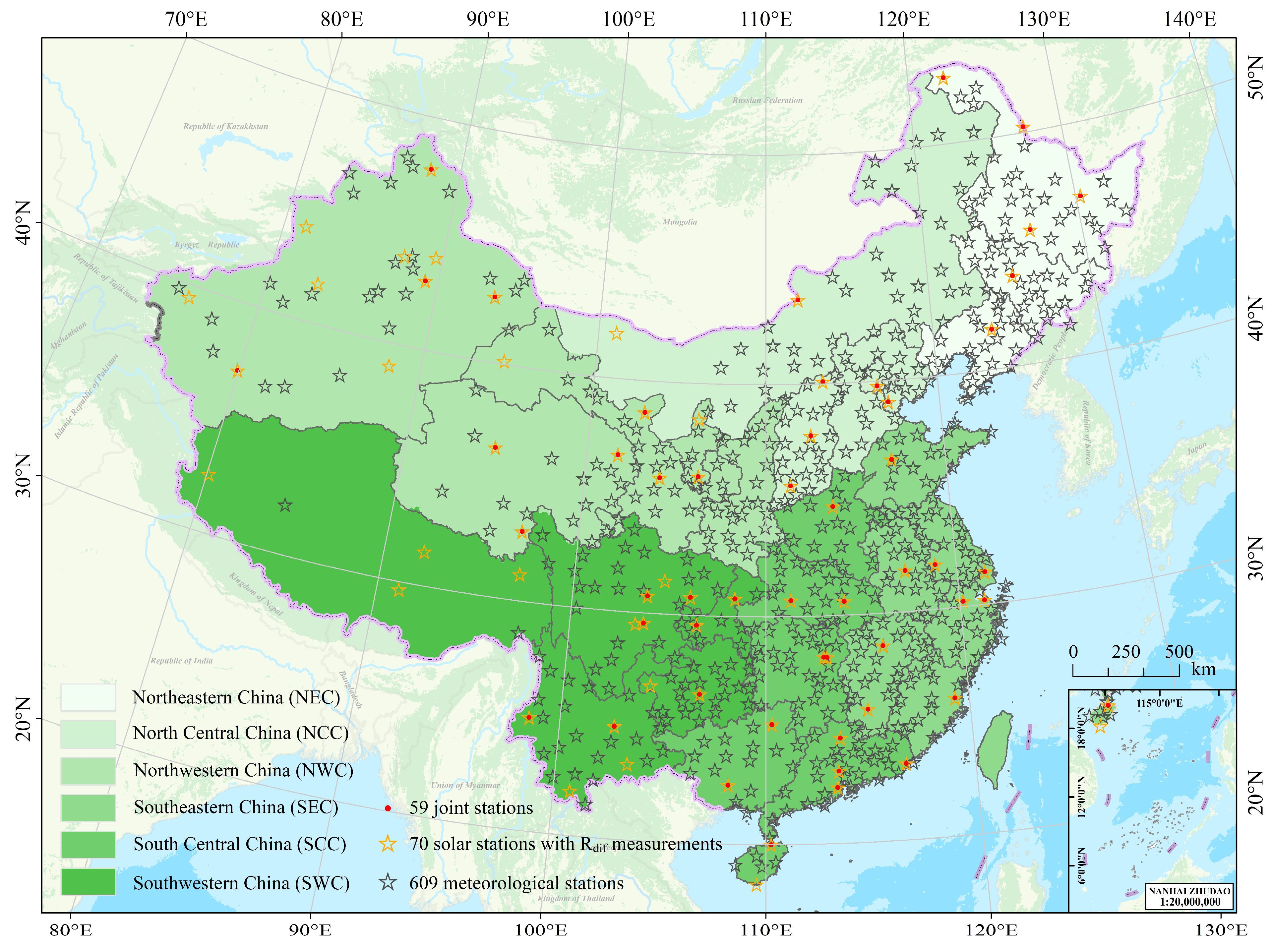
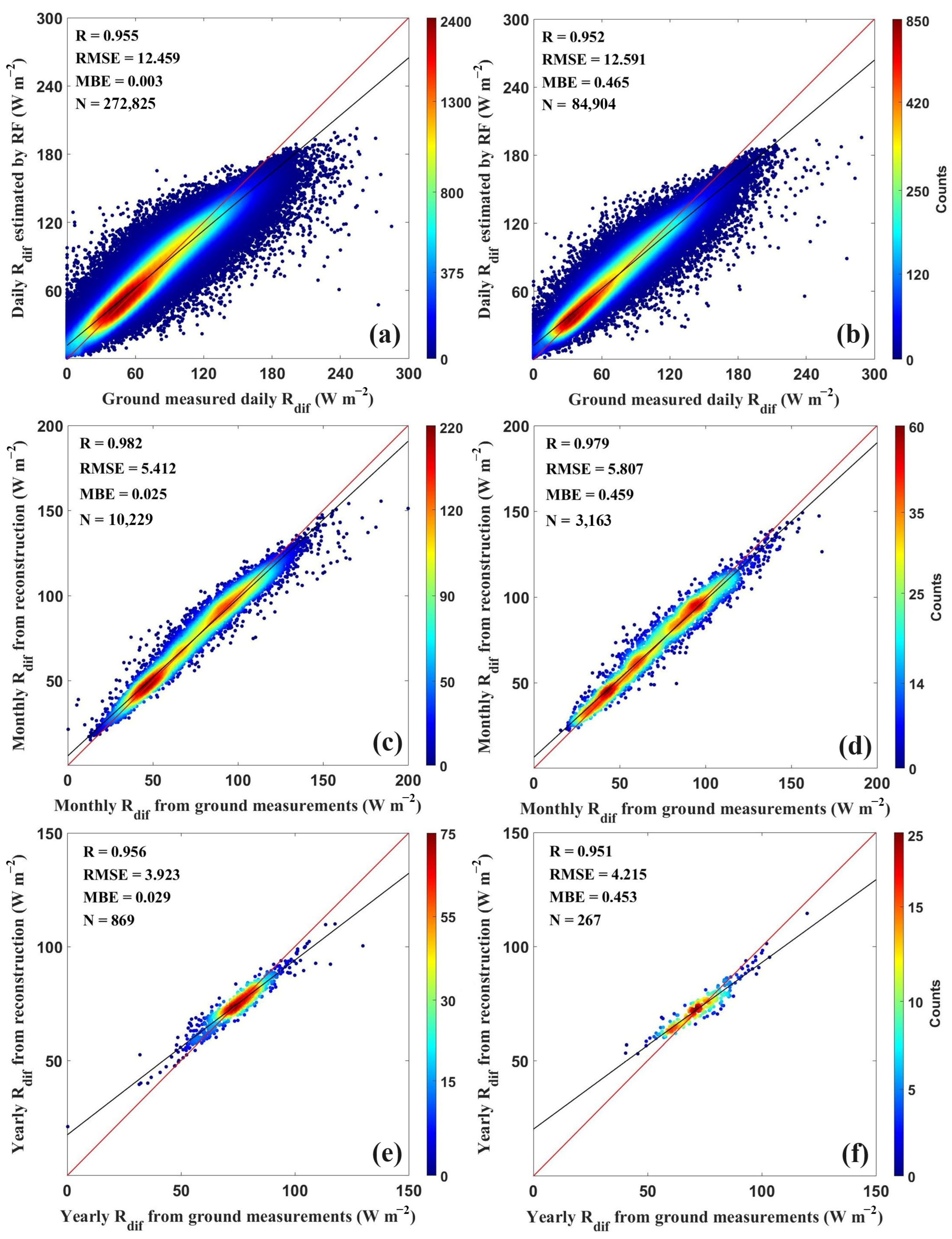
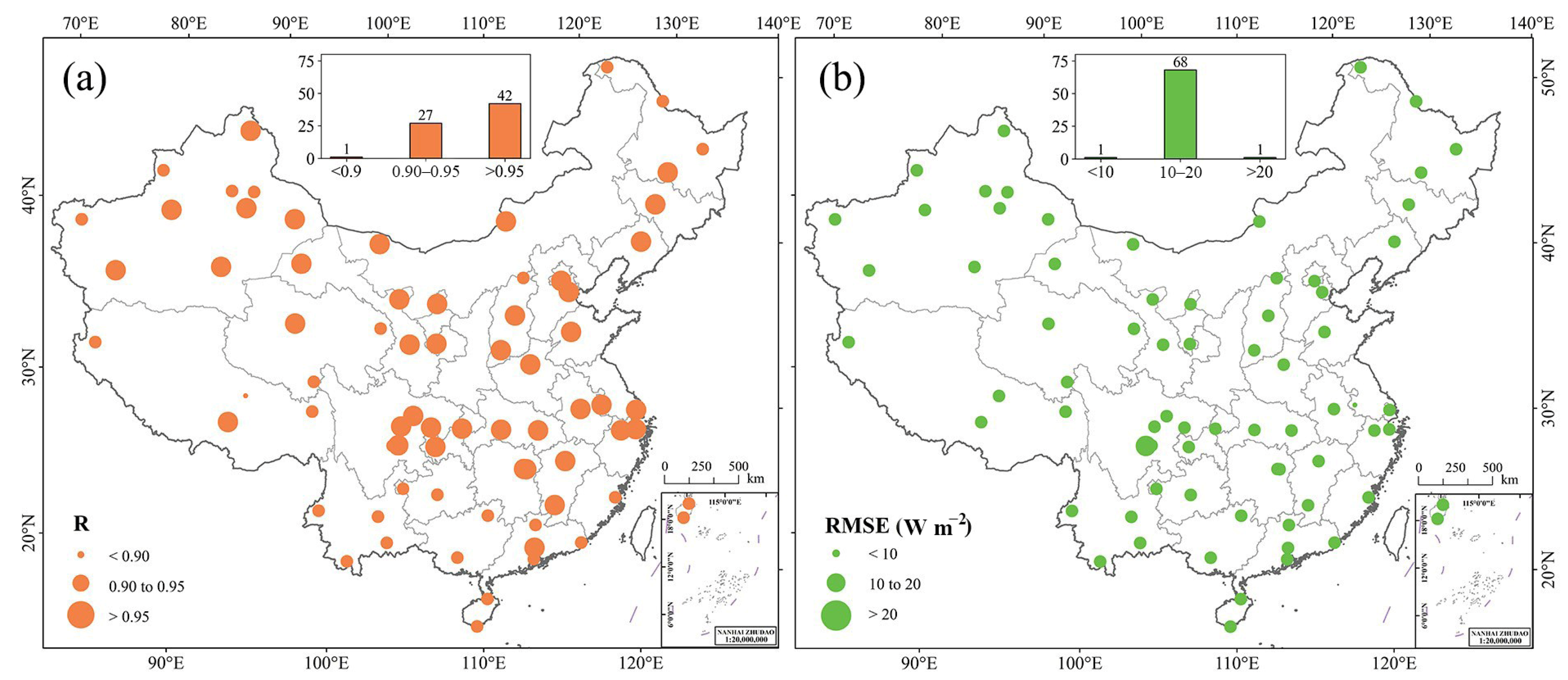
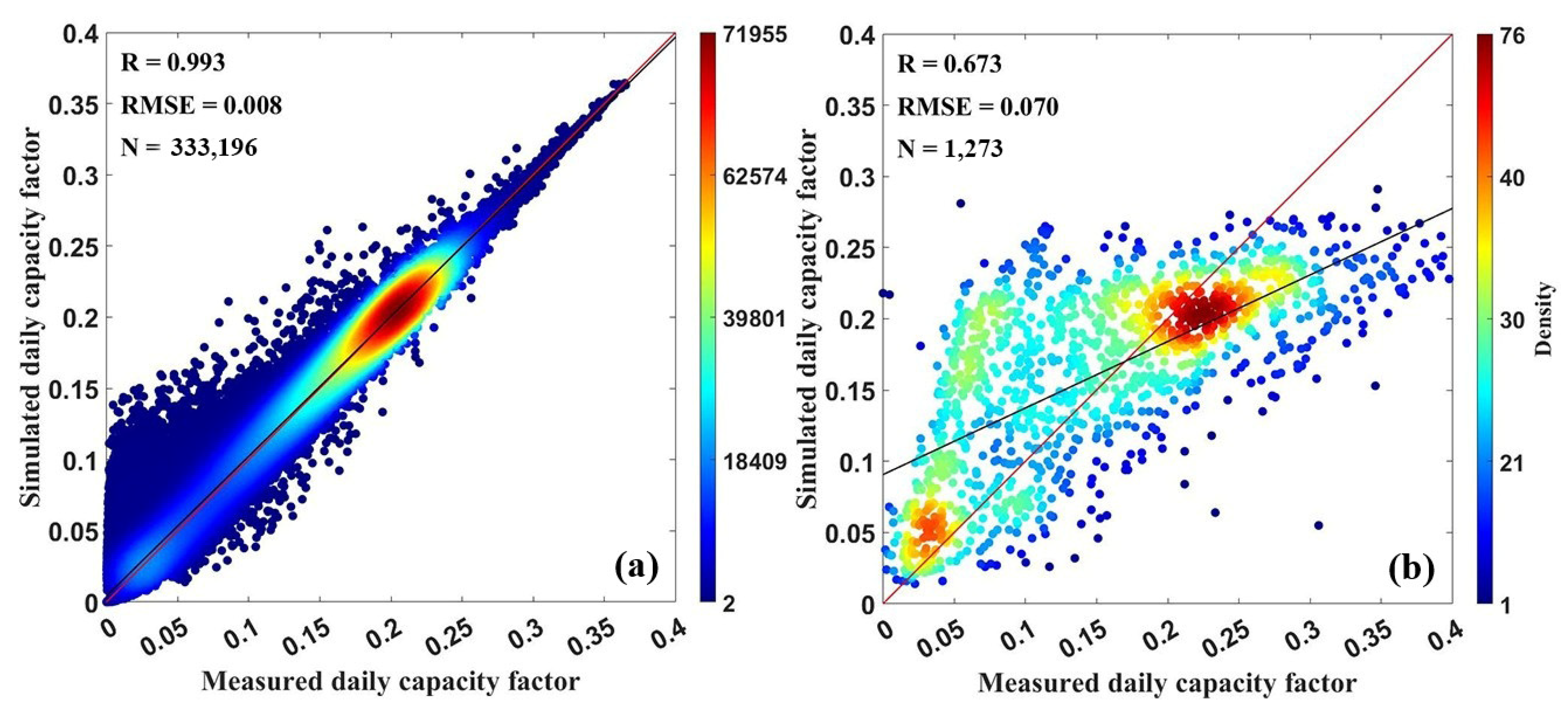
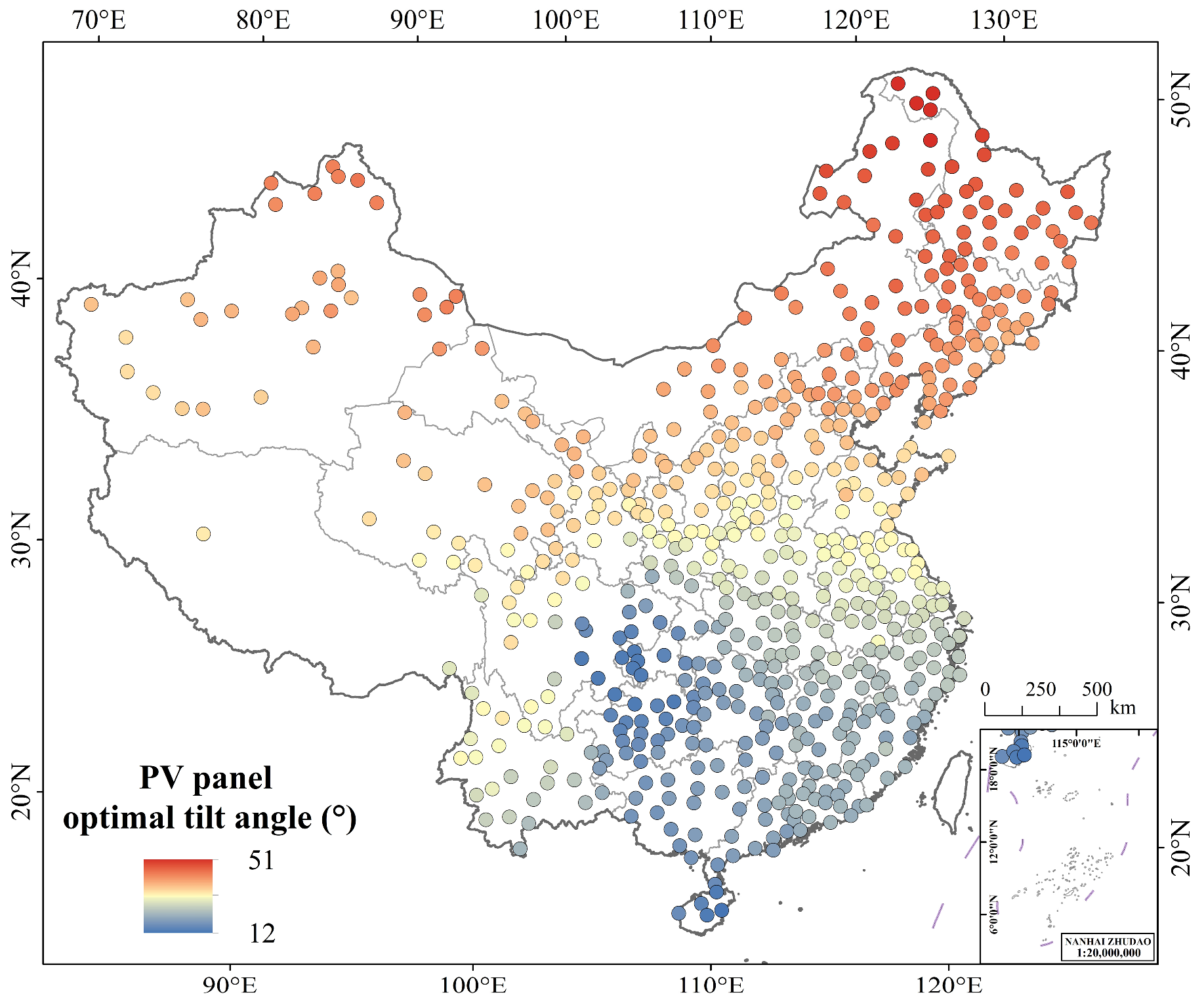
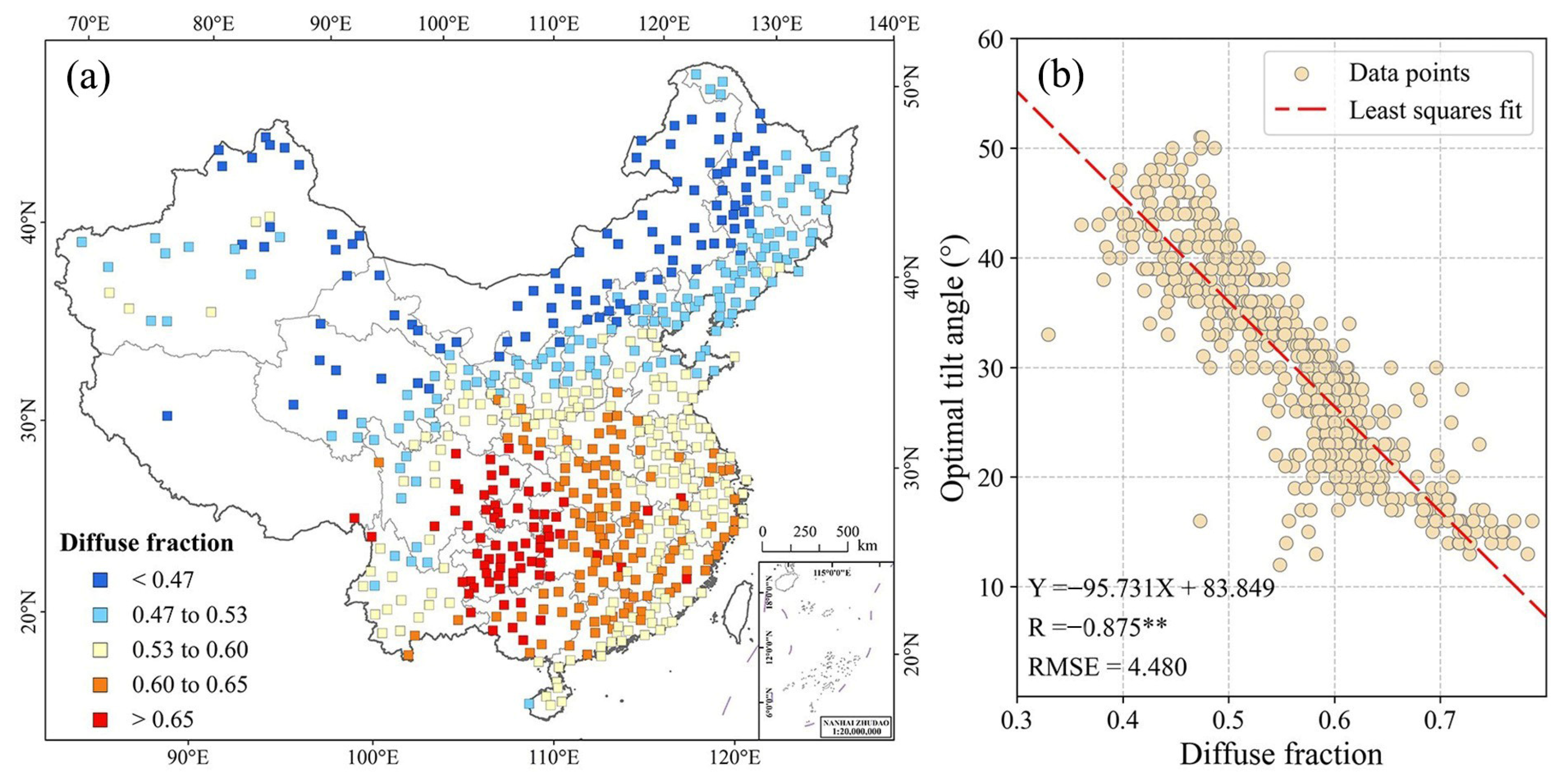
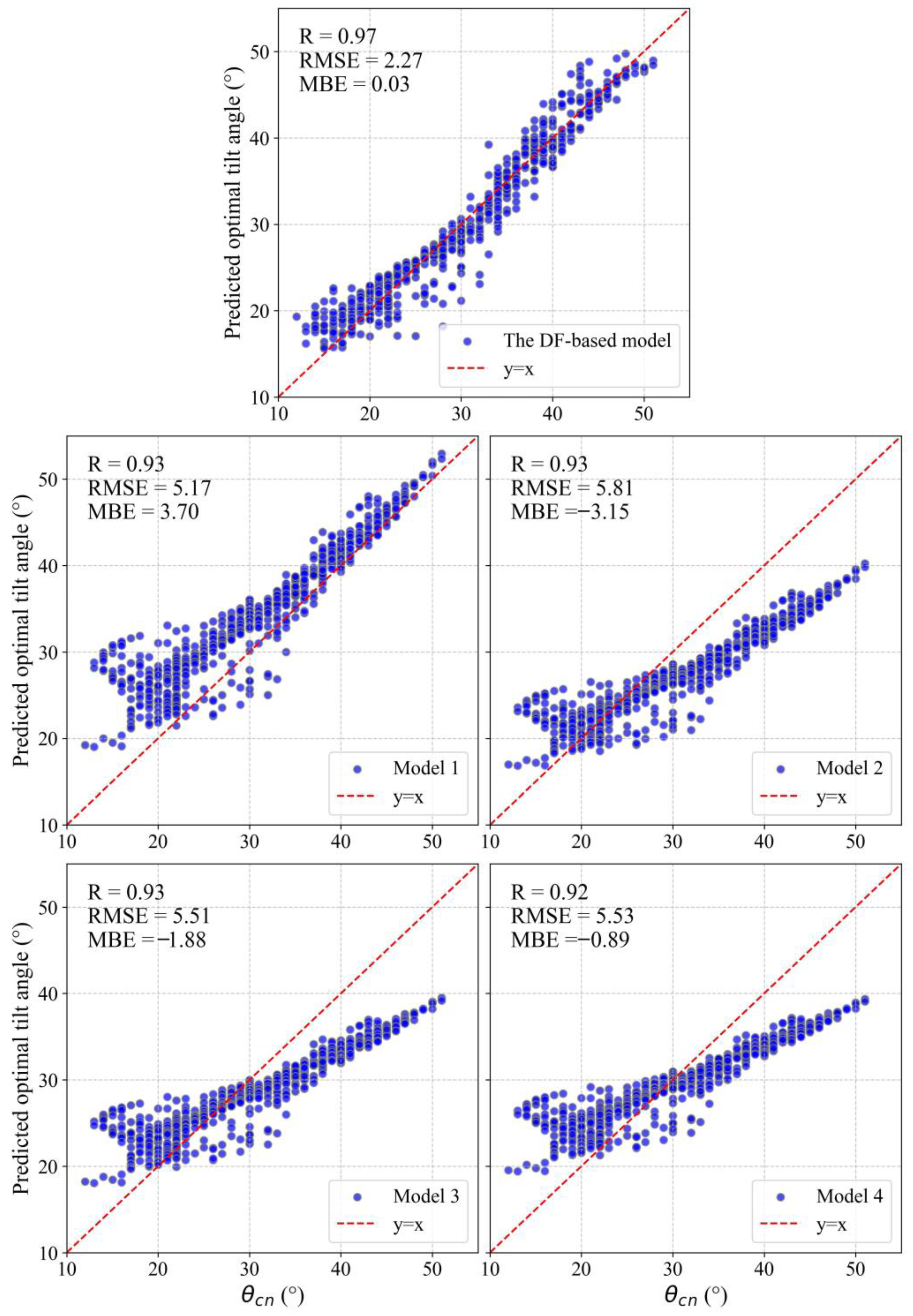
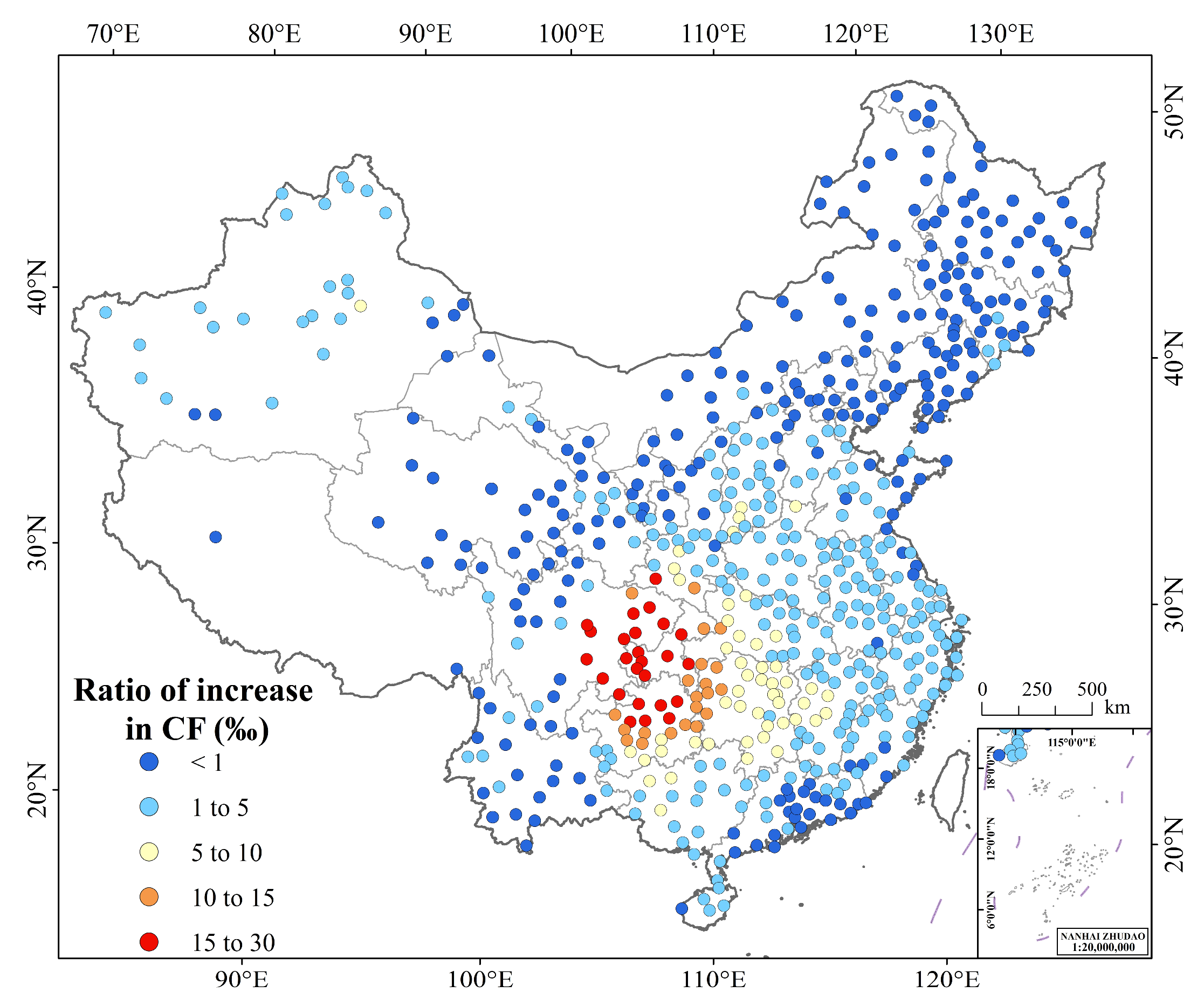
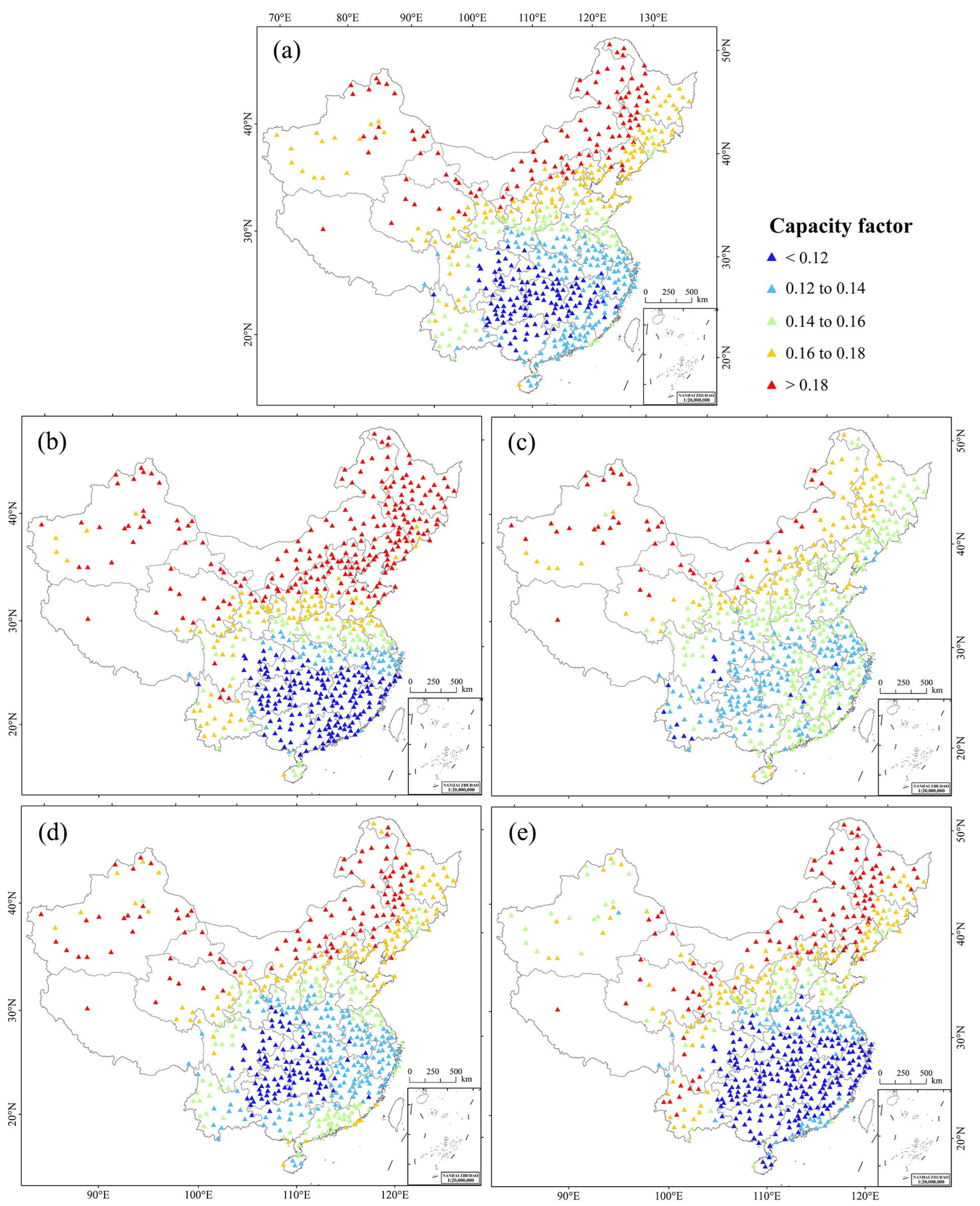
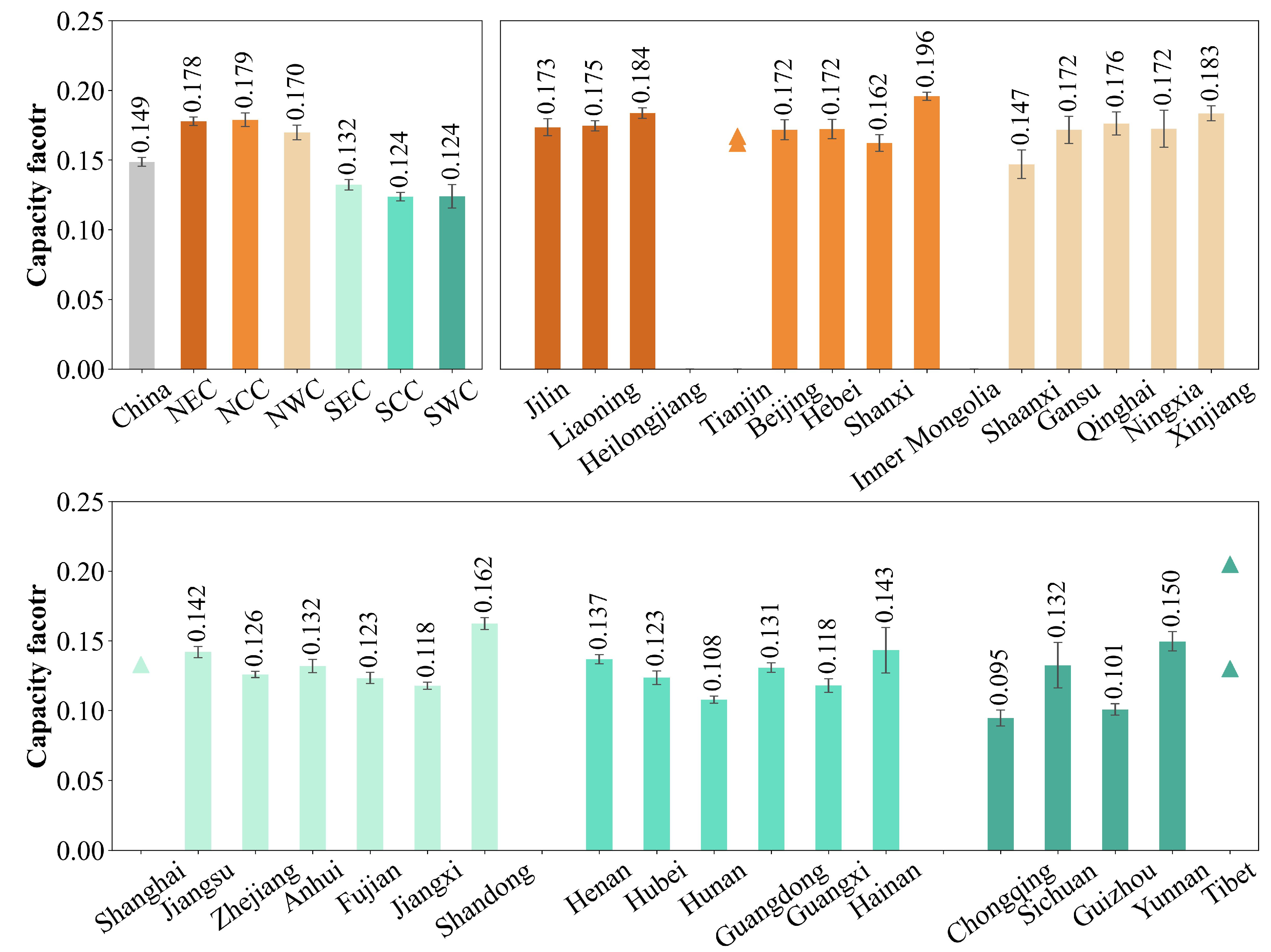
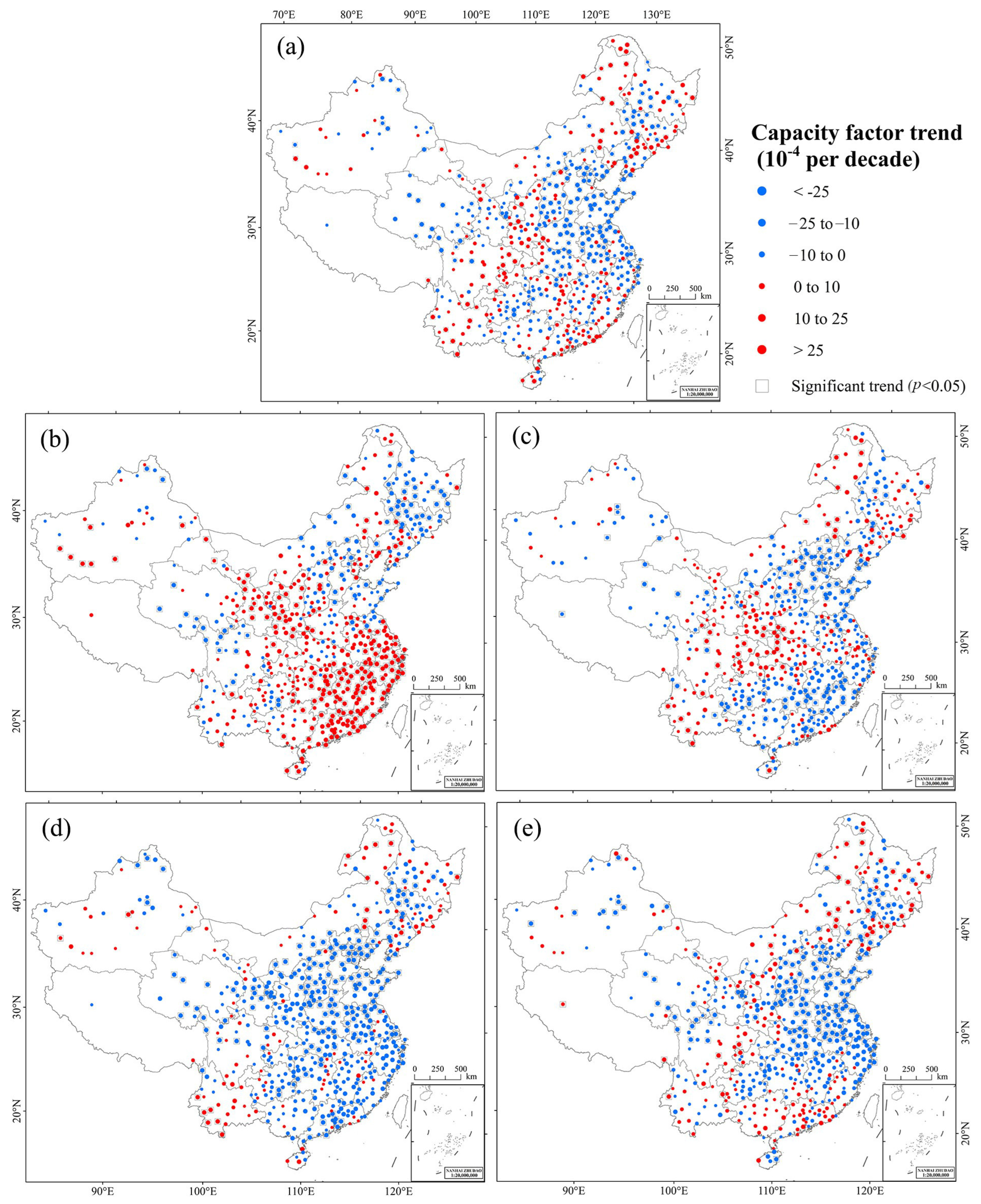
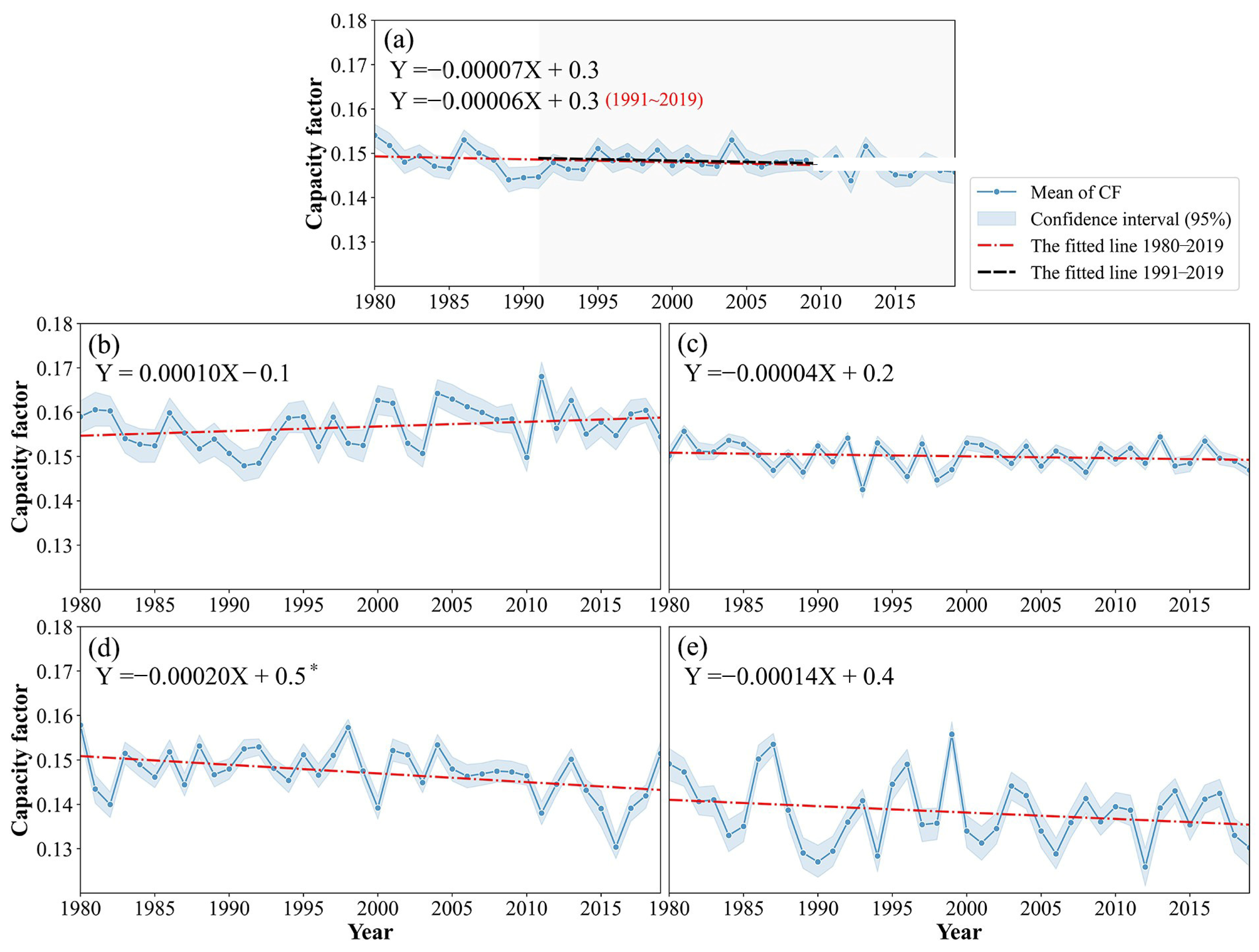
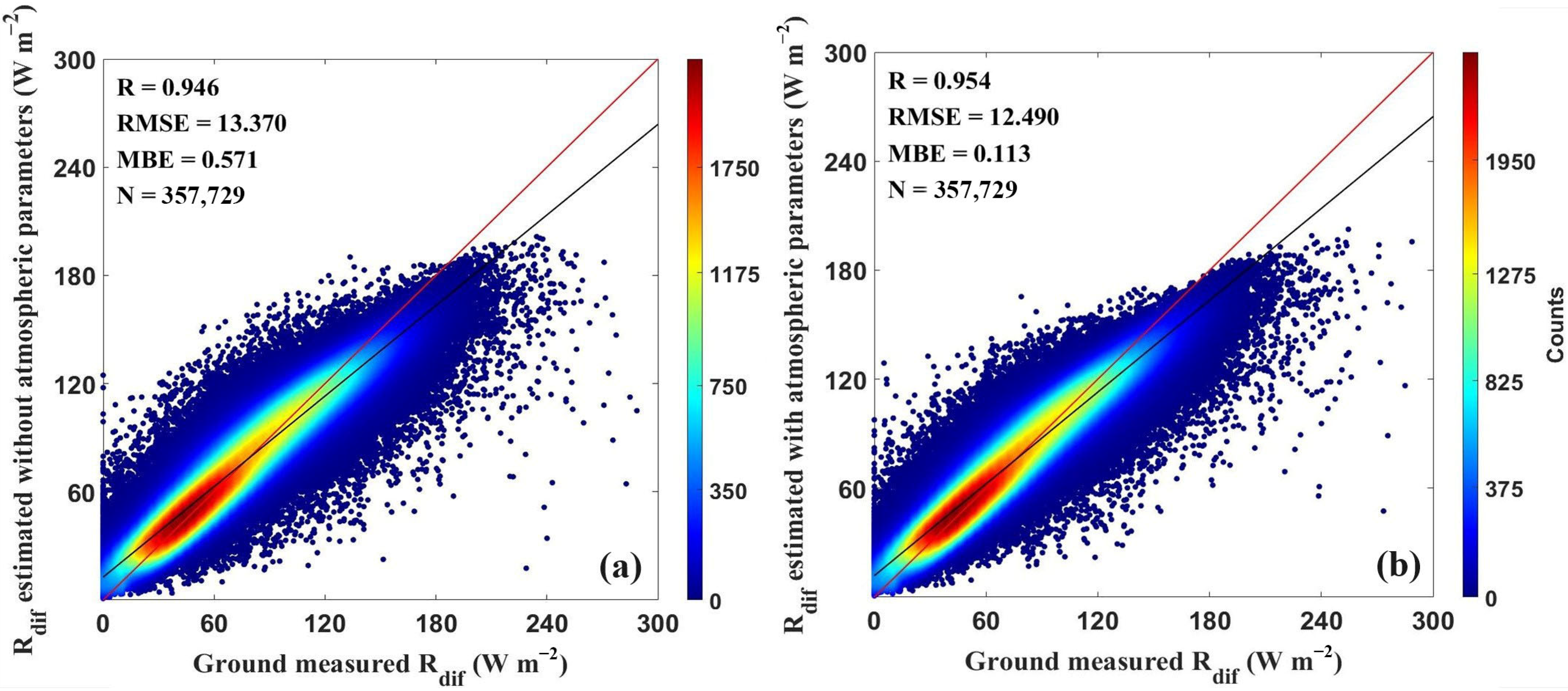
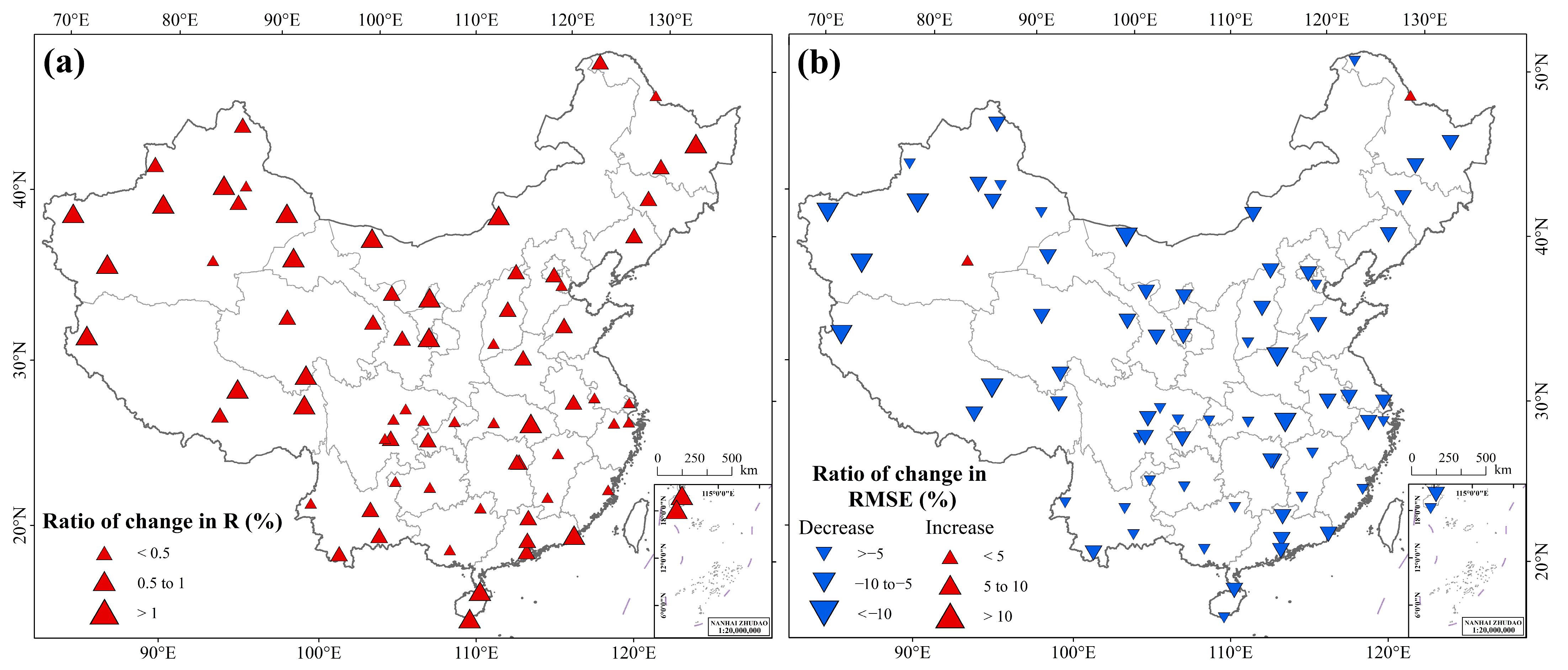
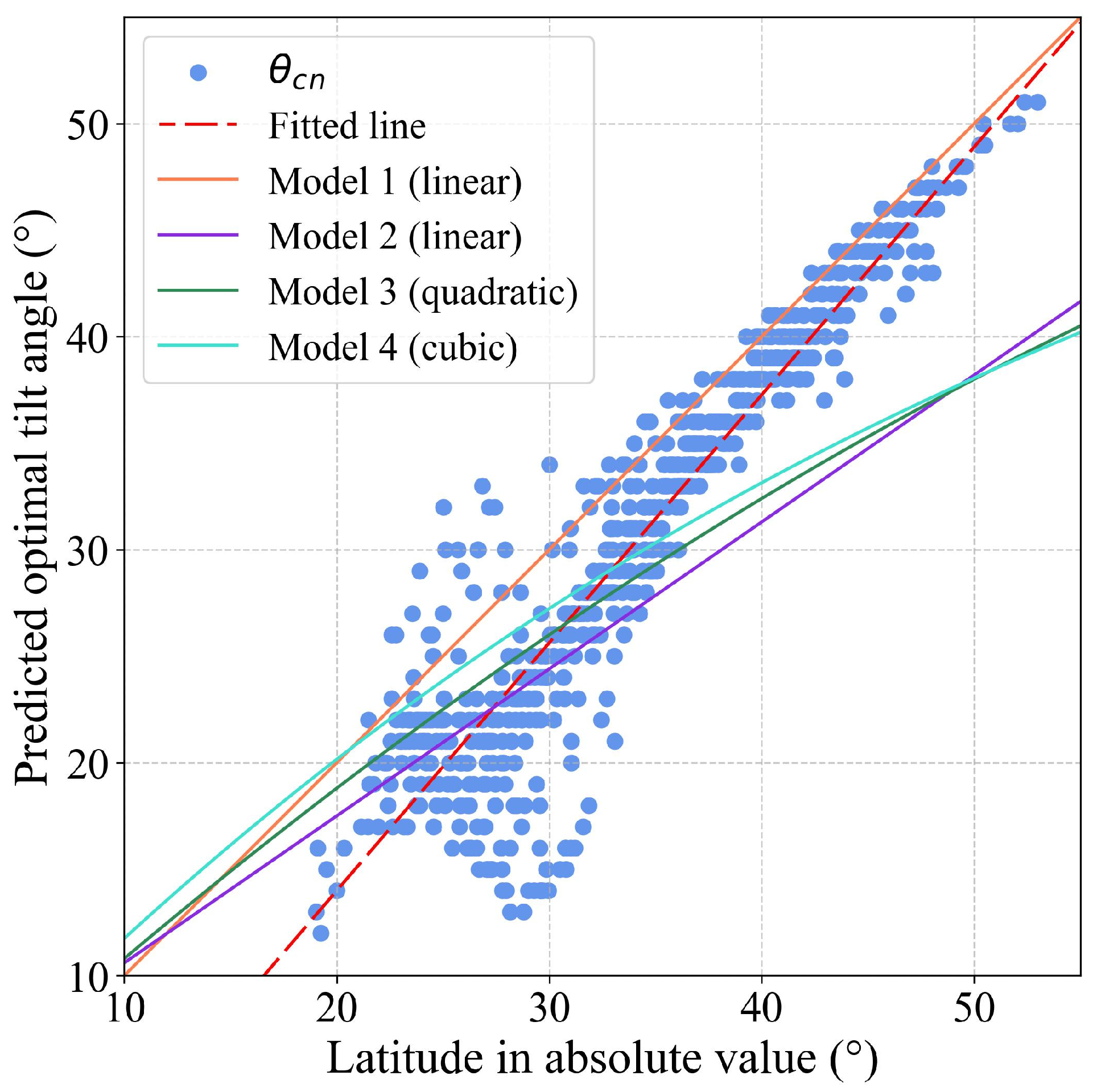
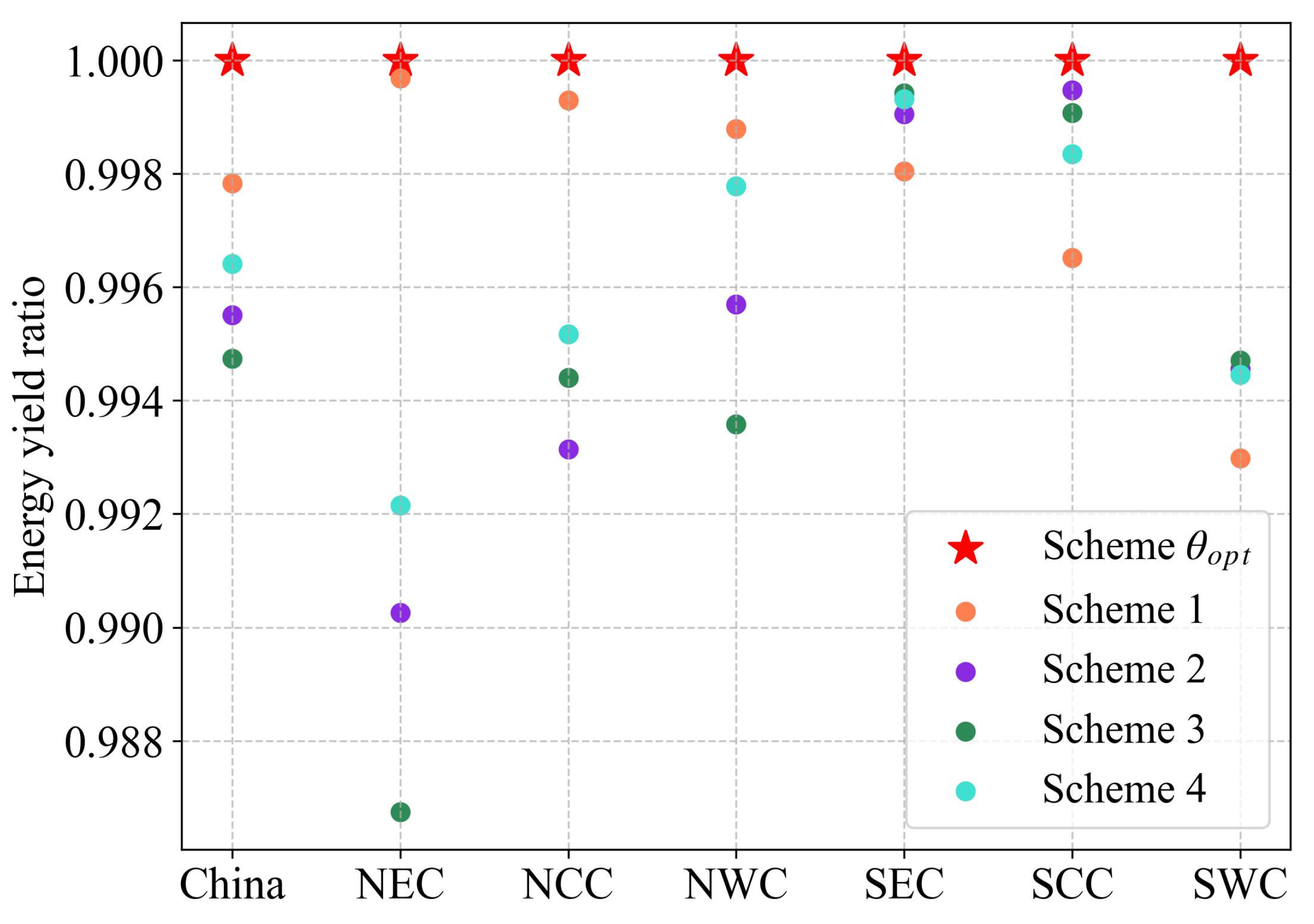
Disclaimer/Publisher’s Note: The statements, opinions and data contained in all publications are solely those of the individual author(s) and contributor(s) and not of MDPI and/or the editor(s). MDPI and/or the editor(s) disclaim responsibility for any injury to people or property resulting from any ideas, methods, instructions or products referred to in the content. |
© 2025 by the authors. Licensee MDPI, Basel, Switzerland. This article is an open access article distributed under the terms and conditions of the Creative Commons Attribution (CC BY) license (https://creativecommons.org/licenses/by/4.0/).
Share and Cite
Zhao, W.; Zhang, X.; Yang, S.; Duan, Y.; Lu, L.; Han, X.; Bu, L.; Jia, R.; Yao, Y. Assessment of Long-Term Photovoltaic (PV) Power Potential in China Based on High-Quality Solar Radiation and Optimal Tilt Angles of PV Panels. Remote Sens. 2025, 17, 3235. https://doi.org/10.3390/rs17183235
Zhao W, Zhang X, Yang S, Duan Y, Lu L, Han X, Bu L, Jia R, Yao Y. Assessment of Long-Term Photovoltaic (PV) Power Potential in China Based on High-Quality Solar Radiation and Optimal Tilt Angles of PV Panels. Remote Sensing. 2025; 17(18):3235. https://doi.org/10.3390/rs17183235
Chicago/Turabian StyleZhao, Wenbo, Xiaotong Zhang, Shuyue Yang, Yanjun Duan, Lingfeng Lu, Xinpei Han, Lingchen Bu, Run Jia, and Yunjun Yao. 2025. "Assessment of Long-Term Photovoltaic (PV) Power Potential in China Based on High-Quality Solar Radiation and Optimal Tilt Angles of PV Panels" Remote Sensing 17, no. 18: 3235. https://doi.org/10.3390/rs17183235
APA StyleZhao, W., Zhang, X., Yang, S., Duan, Y., Lu, L., Han, X., Bu, L., Jia, R., & Yao, Y. (2025). Assessment of Long-Term Photovoltaic (PV) Power Potential in China Based on High-Quality Solar Radiation and Optimal Tilt Angles of PV Panels. Remote Sensing, 17(18), 3235. https://doi.org/10.3390/rs17183235








